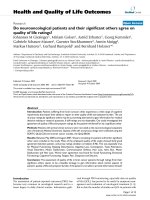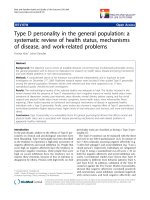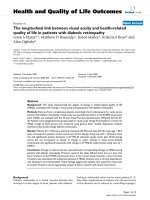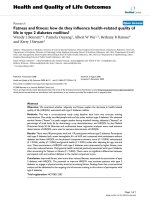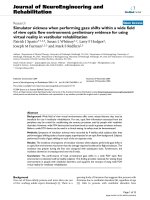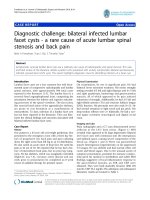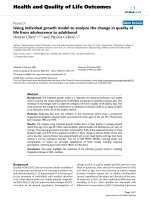Báo cáo hóa học: " Fiber over Wireless Chromatic Dispersion Compensation for a Better Quality of Service" pptx
Bạn đang xem bản rút gọn của tài liệu. Xem và tải ngay bản đầy đủ của tài liệu tại đây (1.7 MB, 6 trang )
Hindawi Publishing Corporation
EURASIP Journal on Wireless Communications and Networking
Volume 2006, Article ID 85980, Pages 1–6
DOI 10.1155/WCN/2006/85980
Fiber over Wireless Chromatic Dispersion
Compensation for a Better Quality of Service
S. Guizani,
1
M. Razzak,
2
H. Hamam,
2
Y. Bouslimani,
2
and A. Cheriti
1
1
Electrical Engineering De partme nt, University of Quebec, Trois-Rivi
`
eres, QC, Canada G9A 5H7
2
Faculty of Engineering, University of Moncton, NB, Canada E1A 3E9
Received 30 August 2005; Revised 13 November 2005; Accepted 22 December 2005
“Anywhere” and, in particular, “anyhow”: these are the two best words that can describe an ad hoc wireless network that is due
to the increasing demand for connectivit y in such an information society. Ad hoc wireless networks can be described as dynamic
multihop wireless networks with mobile nodes. However, the mobility condition can be relaxed, and we can consider an ad hoc
wireless network as a reconfigurable network where all the nodes are connected to the local environment through wireless links,
and where there is not a central or dominant node—as opposed to, for example, the case of cellular wireless networks where a
base station is located in each cell. When ad hoc networks are backboned by fibers, distortion of the optical link presents one of
the major issues. In this paper, we will be addressing one of the fundamental problems, namely, chromatic dispersion in the fiber
optic prior reaching the access points. This will ensure an adequate quality of service (QoS).
Copyright © 2006 S. Guizani et al. This is an open access article distributed under the Creative Commons Attribution License,
which permits unrestricted use, distr ibution, and reproduction in any medium, provided the original work is properly cited.
1. INTRODUCTION
The underlying technology is less and less satisfying the need
and desire of the present communications users who are
incessantly demanding more flexibility (mobility, QoS, any
portable unit, etc.) as well as more capacity (bandwidth).
Indeed, on the one hand, these consumers are asking for
more and more cost-effective communication systems that
can support anytime and anywhere any media they want.
On the other hand, the users of wireless communications
are demanding more capacity and therefore higher frequen-
cies. Unfortunately, these two trends (flexibility and capac-
ity) cannot be simultaneously fulfilled in the scope of wire-
less communications because of the limits of the radio spec-
trum.
A clever solution consists in combining the two com-
plementary technologies, namely, wireless and fiber. The re-
sulting system (Figure 1), commonly referred to as a hybrid
fiber-wireless system, offers a hig h QoS in addition to mo-
bility and immunity to electromagnetic interference with-
out largely occupying additional radio spectrum. While wire-
less systems offer flexibility including mobility, optical fiber
communications provide, in a cost-effective way, the massive
bandwidth that fuelled the huge demand on Internet traffic,
videoondemand,andsoforth.
In particular, ad hoc networks offer total mobility. Two
main categories of ad hoc networks are distinguished. The
first category consists in ad hoc networks that can function
as standalone networks meeting direct communication re-
quirements of their users. In addition to existing ad-hoc in-
frastruc ture, the second category will be used to extend and
enhance the coverage of the first. The second category, which
presents a valuable solution to incomplete networks, can be
connected via a radio access point to an optical link leading
to high-speed fiber-based ad hoc wireless access systems. In
this situation, the connection to the fiber and possibly to In-
ternet requires a fixed a ccess point (Figure 1). The optimiza-
tion of the rapidity of such a system will be a subject of future
work where hardware as well as networking issues are of con-
sideration.
The wireless-optic combination is however not without
its difficulties. One of the major difficulties is chromatic dis-
persion that is a serious source of intersymbol interference
(ISI). In fact, since higher bit rates require smaller pulse
width, sources of wave distortion, such as chromatic disper-
sion and nonlinear effects, become not negligible. In this pa-
per, we focus on one of the most important limitations of
high bit rate transmission, namely, chromatic dispersion of
order 2. Higher orders will be subject to future work. Our so-
lution for dispersioncompensation is based on a well-known
2 EURASIP Journal on Wireless Communications and Networking
WLAN
LAN
LAN
WLAN
Ad hoc
Ad hoc
Cellular
CellularInternet
Figure 1: A possible wireless infrastructure topology.
phenomenon in physical optics, namely, the self-imaging ef-
fect, also commonly cal led the Talbot effect.
The remainder of this paper is organized as follows.
Section 2 enumerates some advantages for high-speed fiber-
based wireless systems in a separate subsection. Then, some
of the issues with fiber backboned ad hoc wireless networks
are outlined. Section 3 briefly discusses fiber impairments
that may result in a significant reduction of the QoS of the
ad hoc network. Section 4 presents Talbot-based compensa-
tion method where our solution lies. Section 5 addresses the
mathematical background of limitation considered in this
paper, namely, chromatic dispersion. After briefly covering
the temporal Talbot effect, for illustration, simulation results
are given in Section 6. Finally, Section 7 presents some dis-
cussions of the results.
2. HIGH-SPEED FIBER-BASED WIRELESS NETWORKS
2.1. Advantages of high-speed fiber-based
wireless systems
As stated above, while the wireless part (subsystem) of the hy-
brid system offers mobility, the main contribution of the op-
tical fiber communication subsystem is to transmit the maxi-
mum number of bits per second over the maximum possible
distance with the fewest errors. Optical fiber is still the best
medium for long-haul and very-high-bit-rate transmissions.
It is considered as a low-cost solution to respond to the ex-
ponential needs of bandwidth to carry huge data required
for exponential demand of bandwidth for the Internet and
related technologies.
Besides, the fiber can b e combined to wireless to offer
many advantages such as huge capacity (bandwidth) that
enables multiplexing several radio frequency (RF) channels.
As a consequence, each RF channel may belong to a differ-
ent system such as a d hoc wireless and cellular systems. The
transmission of RF signals over the fiber allows for trans-
parent operation because the RF to optical modulation is
typically independent of the base band to RF modulation.
Third, in continuity with the last point, hybrid wireless-fiber
systems allow for easy integration and upgrades since the
electrical-to-optical conversion is independent of baseband-
to-RF modulation format. Fourth, the introduction of the
optical link offers immunity to electromagnetic interference.
Fifth, no additional infrastructure effort is required to pro-
vide high-speed fiber-based wireless networks since the al-
ready installed fibers running in our neighbor hood in most
major cities can be used for this purpose.
2.2. Issues with fiber backboned ad hoc
wireless networks
In hybrid wireless-optical systems, chromatic dispersion is
particularly a major issue. Indeed, transmitting traditional
double sideband (DSB) signals is problematic due to chro-
matic dispersion. This frequency-dependent fiber dispersion
produces a deleterious time delay b etween the two trans-
mitted sidebands, causing serious RF power fading that
is a function of subcarrier frequency, fiber distance, and
accumulated dispersion. Indeed, if the RF signal (with op-
tical carrier) is transmitted over fiber, chromatic dispersion
causes each optical sideband to experience a different phase
shift, which varies with fiber length, radio frequency, and
fiber dispersion parameter [1, 2]. Thus, using the conven-
tional DSB modulation scheme, the RF power detected at the
base station suffers from a periodic degradation due to the
fiber chromatic dispersion. As the RF frequency or fiber-link
distance increases, this effect is even more severe and limits
the system performance [3, 4].
In particular, the use of ad hoc wireless networks, used
as an extension to an existing infrastr u cture, may amplify the
difficulty of chromatic dispersion. Indeed, total mobility is
one of the most common reasons to apply ad hoc topologies.
Each node in a wireless ad hoc network has a wireless access
interface and is free to enter or leave the network at any time.
Thus, it is desir able not to modify each mobile node because
of the constraints of wireless-fiber link including limitations
due to high-speed transmission. Each node should not be
aware of the existence of this link leading to a transparent
seamless information flow between the fiber and the portable
units.
S. Guizani et al. 3
E
x
E
x
E
E
y
Fiber
PMD
E
y
DGD
(a)
I
Fiber
GVD
T
ΔT
(b)
Figure 2: (a) PMD: polarisation mode dispersion, DGD: differential group delay, E: input field, E
: output field, E
x
: x-component of the
field, (b) GVD: group velocity dispersion.
3. FIBER IMPAIRMENTS
Nonidealities of optical fiber place restr ictions on the dis-
tance that can be tolerated without introducing signal regen-
erators, in-line optical amplifiers. These nonidealities can be
broadly classified into attenuation which causes a loss in the
signal power, distortion which causes pulse broadening, and
thus ISI, and fiber nonlinearity which causes self phase mod-
ulation, cross phase modulation, and four wave mixing in
WDM.
3.1. Attenuation
Attenuation in fiber occurs due to absorption, scattering, and
radiative losses of the optical energy. Absorption losses are
caused by atomic defects in the glass composition, intrin-
sic absorption by atomic resonance of fiber material, and ex-
trinsic absorption by the atomic resonance of external parti-
cles (like O H ion) in the fiber. Scattering losses in fiber arise
from microscopic variations in the material density and from
structural inhomogeneities. There are four kinds of scatter-
ing losses in optical fibers, namely, Rayleigh, Mie, Brillouin,
and Raman scattering. Radiative losses occur in an optical
fiber at bends and curves because of evanescent modes gen-
erated [5–8].
3.2. Signal distortion
Optical fiber, by its very nature, is a dispersive media.
As an optical signal travels through the glass, it becomes
more and more distorted over longer distances for a vari-
ety of reasons. The primary contributors to signal distortion
are polarization-mode dispersion, chromatic dispersion, and
fiber nonlinearities. A brief description of these three phe-
nomena shows how each affects the signal within the optical
fiber.
(i) Polarization-mode dispersion. Polarization-mode dis-
persion (Figure 2) is another phase-related distortion.
As light is polarized in the optical fiber, the two po-
larizations travel at different speeds within the glass.
The resulting phase distortion between the two polar-
izations is known as polarization-mode dispersion.
(ii) Chromatic dispersion. Chromatic dispersion is a varia-
tion in the velocity of light (group velocity) according
to wavelength. This variation in velocity, which will be
mathematically developed in the next section, causes
the pulses of a modulated laser source to broaden
when traveling through the fiber, up to a point where
pulses overlap and bit error rate increases. As this in-
crease in bit error rate interferes with both the qual-
ity and speed of the signal, chromatic dispersion (CD)
is a major limiting factor in high-speed transmission.
Therefore, to ensure adequate quality of service (QoS),
it is extremely important that carriers compensate for
this type of signal distortion. The widespread use of
DWDM systems covering the C and L bands (1530 nm
to 1625 nm) will certainly create a need for accurate
wideband CD compensators.
4. TALBOT-BASED COMPENSATION
4.1. Self-imaging
Light propagation is a spatial phenomenon and therefore it
associates three dimensions x, y (transversal), and z (prop-
agation) in a physical harmony, maintained by the princi-
ple of energy conservation in any longitudinal position z in
free space. Because periodicity presents a spatial link in the
transversal plane (x, y), it allows the association mentioned
above to be the source of interesting optical effects observed
at particular distances z [5, 9]. Depending on the nature (spa-
tial or temporal) of the periodic structures, we distinguish
two phenomena: spatial Talbot effect and temporal Talbot
effect. For the purpose of dispersion compensation, we will
focus on the temporal Talbot effect.
The temporal Talbot effect occurs when a periodic se-
quence of pulses, produced by a laser for example, propagates
in a dispersive medium. We remind the reader that a disper-
sive medium is a medium in which the various harmonics,
composing the pulse, propagate with different speeds, there-
fore causing a stretching of the pulse during propagation.
When a periodic pulse train, with period T,progres-
sively propagates in a dispersive medium, it undergoes a tem-
poral widening in its both wings. At a certain distance of
propagation, each pulse overlaps with its two neighboring
pulses. Thus, information transported by the periodic signal
is affected. For further transmission distances, the widened
pulses continue stretching so that each one may overlap with
several pulses in both sides. We then observe several ar-
eas along the axis of propagation where either construct ive
or destructive superimposition occurs. As will be explained
later in the analysis section, for particular distance z, the ar-
eas of constructive or destructive superimposition may be
4 EURASIP Journal on Wireless Communications and Networking
distributed so that the initial periodic train is integrally re-
observed. T his phenomenon of s elf-imaging is referred to as
the temporal Talbot effect.
The overlapping of the widened pulses may be construc-
tive in some areas and destructive in other areas so that
new pulses, having the same shape of the initial pulses, are
formed. Thus, the period train contains additional pulses
and consequently the frequency of the pulses is doubled,
tripled, and in general replicated N times. It deals in this case
with the temporal fractional Talbot effect [5, 9].
5. PROPOSED METHOD BASED ON TALBOT EFFECT
Pulse propagation through optical fiber is widely described in
several literatures. In its easiest formulation when the pulse
width is larger than five picoseconds under the assumption
of slowly varying envelop approximation (SVAE), the varia-
tion of the complex envelop u(t) is governed by the nonlinear
Schr
¨
odinger equation (NLSE)
i
∂u
∂z
+
i
2
αu
−
1
2
β
2
∂
2
u
∂T
2
−
i
6
β
3
∂
3
u
∂T
3
+ γ|u|
2
u = 0, (1)
where α is the attenuation coefficient, T
= t − β
1
z is the re-
lated time frame, γ is the nonlinear parameter known as self-
phase modulation (SPM), and β
2
and β
3
are, respectively, the
second- and third-order dispersion parameters referred to as
the group velocity dispersion (GVD) and third-order disper-
sion (TOD). While dispersion is responsible for a temporal
broadening of the signal, SPM effect is observed in the spec-
tral domain through a spectral enlargement. With the aim of
quantifying the effec t of those phenomena along a transmis-
sion length, it is practical to introduce some characteristic
variables; L
D
= T
2
0
/|β
2
|, L
D
= T
3
0
/|β
3
|,andL
N
= 1/γP
0
are,
respectively, the second- and third-order dispersion lengths,
and the nonlinear lengths. In what follows, we consider a
lossless medium (α
= 0).
Generally, the GVD effect is more important than TOD
(L
D
L
D
) and the latter is usually neglected except in the
ultrashort pulses (> 100 Gbit/s) and in the zero-dispersion
conditions. When L
D
∼
=
L
N
, both GVD and SPM effects have
a comparable contribution. In this case, Soliton-like pulse is
the ideal signal shape for very long distances. This pulse is
the analytical solution of the NLSE using inverse scattering
method [6]. It results from the interplay between GVD and
SPM effects. When L
N
z, the most contribution of physi-
cal phenomenon arises from the chromatic dispersion. So (1)
can be easily solved in Fourier domain:
U(w, z)
= U(w,0)exp
i2πD(w)z
,(2)
where D(w)
= ((β
2
/2)w
2
+(β
3
/6)w
3
).
Both nonlinearity and dispersion effects are undesirable
in optical fiber transmission. They distort the propagated sig-
nal resulting in intersymbol interference.
Let us turn back to the Schr
¨
odinger equation (1), neglect
nonlinearity (γ
= 0) and fiber loss, and normalize the com-
plex amplitude and the time scale:
i
∂u
∂z
=
1
2
β
2
∂
2
u
∂T
2
,(3)
where u(z, τ) is the normalized amplitude (P
0
: the peak pow-
er of the incident pulse):
g(z, τ)
=
P
0
exp
−
αz
2
u(z, τ)(4)
and τ
= T/T
0
is the normalized time (T
0
: pulse width).
The Fourier transform of the solution of the differential
equation (5)isgivenby
U(z, ω)
= U(0, ω)exp
i
2
β
2
zω
2
,(5)
where U(0, ω) is the Fourier transform of the optical sig-
nal u(0, τ) that was injected into the fiber and U(z, ω)is
the Fourier transform of the signal exiting this dispersive
medium.
Equation (6) points out that the Fourier transforms of
the input and output signals are identical except for a phase
term. They may be exactly identical if this term is neutralized,
exp(i(β
2
/2)ω
2
z) = constant.
Unfortunately, this term is a continuous function in ω
and is not constant. However for discrete values of ω, this
function may take a constant value.
Then, exp(i[(β
2
/2)ω
2
]z) is equal to 1 if only the angular
frequencies ω, satisfying the following relations, are active:
β
2
2
ω
2
z = 2kπ,(6)
where k is an integer.
In particular, a periodic signal u(0, τ) may satisfy this
condition. Indeed, its Fourier transform is sampled with the
sampling interval 1/T where T is the period of the signal.
Thus, only the angular frequencies ω
= 2πnf = 2πn/T are
active (n is an integer). Let us see whether there is a particu-
lar distance z for which relation (6) is fulfilled. We can easily
prove that all periodic distances of the form z
= mZ
T
where
Z
T
= T
2
/πβ
2
satisfy this relation. As mentioned above, the
distance Z
T
is referred to as the Talbot distance (see next sec-
tion). We intend to use this phenomenon to perform post-
compensation of chromatic dispersion (CD). Before tackling
our technique, let us briefly address the phenomenon of tem-
poral Talbot effect.
6. SIMULATION RESULTS
We provided a simulation of light propagation through a
dispersive medium in form of an applet that is publicly as-
sessable through an Internet browser [10]. In addition, we
simulated periodized signal at the receiver side and the re-
transmitted the signal through another dispersive medium as
illustrated in Figure 3.Indeed,Figures4 and 5 show the ob-
tained simulated results using the optical post-compensation
S. Guizani et al. 5
Z
T
= Z
1
+ Z
2
Periodizer
Z
1
Z
2
Fiber (Tx)Fiber(Rx)
Filtered
Figure 3: Schematic model of the post-compensation model.
Figure 4: Received signal after transmission along the fiber (Tx)
and periodization and propagation through the fiber (Rx); the un-
wanted signal could be filtered as shown above.
technique based on the temporal Talbot effect in an optical
transmission link. Figure 4 shows that after 237 km, we ob-
tained exactly the same transmitted signal ( β
2
=−22.00, this
parameter can be modified in the applet). The signal is repre-
sented by 1024 samples. The sampling interval is dt
= 1.0ps
and the pulse width is T
0
= 16 ps. We choose the input bit se-
quence 0101110. The user of the applet can choose any other
sequence. This sequence is coded according to the RZ code.
Four encoding formats are available: RZ, NRZ, Duobinary
RZ, Duobinary NRZ. The applet al l ow to display the input
and output signal as well as the spectrum of the input sig-
nal, which is identical to that of the output sig nal in terms of
intensity profile. Figure 5 shows the effect of chromatic dis-
persion on the same signal with the same parameters as in
Figure 4. Also one can notice that the received signal is dras-
tically deformed and it would be almost impossible to restore
the signal without the post-compensation technique.
7. DISCUSSION AND CONCLUSION
The proposed method is an optical post-compensation tech-
nique based on the temporal Talbot effect as seen in Figure 2.
After propagation through the dispersive medium with a
length Z
1
, the received signal is unfortunately affected by
fiber impairments, mainly CD, as shown in Figure 2. Indeed,
it may be significantly corrupted and totally deformed so that
its reconstruction becomes very difficult not to say impossi-
ble. Our alternative consists of introducing a periodizer and
propagating the periodized signal through another standard
fiber with length Z
2
in such a way that Z
1
+Z
2
= nZ
T
,wheren
is a positive integer. The propagated signal along the distance
Z
2
is an exact replica of the originally transmitted signal.
Figure 5: Received signal without the Talbot-effect-based post-
compensation.
Then a truncation process is performed at the very end to
restore the wanted signal.
This method has many advantages; to name a few,
(1) signal received may be totally altered;
(2) it offers total degree of freedom in choosing the period,
the high-order Talbot distances;
(3) no need to increase the number of repeaters, which
leads to the decrease in the cost;
(4) it is independent from the bit rate sent originally,
meaning that it can handle bit rates in excess of 40
Gbit/s;
(5) no special fiber is required. Standard single mode fi-
bers can be used.
All the above-mentioned advantages lead to a better QoS in
an ad hoc network w here dynamic reconfiguration of a wire-
less network without the need of a centralized control is pos-
sible. This network is crucial for communications between
hosts without any existing infrastructure. So, for some appli-
cations, an ad hoc network needs to be linked to a wired net-
work to have access to Internet or/and other related services
via wireless local area networks. In a wireless access point, the
big challenge is to allow transporting heterogeneous services
with transparency. Radio over fiber solution is proposed. It
takes advantage of the optical fiber capacity to carry RF sig-
nals. This is performed by directly modulating the RF signal
by means of an electro-optic modulator. In a heterogeneous
wireless network, the base station should be able to pro-
vide differ ent services for different distant hosts. Even though
the bit rate in an ad hoc network is not very constraining
for a standard wired network, transporting other services si-
multaneously can increase the transmission bit rate rapidly.
Then the chromatic dispersion problems appear in the fiber
link depending on modulation format of the transmitted ra-
dio signal where the quality of transmission is being im-
proved by using chromatic dispersion compensation stages
over the fiber link. For a best chromatic dispersion com-
pensation network configuration, a preequalization is sug-
gested in the downlink and a postequalization in the uplink
leading to simple BS architecture. In this paper, a new tech-
nique is proposed to compensate the chromatic dispersion
6 EURASIP Journal on Wireless Communications and Networking
optically by applying Talbot effect. Results obtained are in-
line with what’s proposed. This method is easy to implement
and versatile since any type of fiber can be used. Moreover,
our technique has the strength to revive a totally deformed
signal regardless of the bits transmitted.
REFERENCES
[1] G.H.Smith,A.Nirmalathas,J.Yates,andD.Novak,“Disper-
sion effects in millimeter-wave fiber-radio systems employing
direct-sequence code division multiple access,” Optical Fiber
Technology, vol. 5, no. 2, pp. 165–174, 1999.
[2]G.P.Agrawal,Nonlinear Fiber Opt ics, Academic Press, San
Diego, Calif, USA, 3rd edition, 2001.
[3] J. Han, B J. Seo, Y. Han, B. Jalali, and H. R. Fetterman, “Re-
duction of fiber chromatic dispersion effects in fiber-wireless
and photonic time-stretching system using polymer modula-
tors,” Journal of Lightwave Technology, vol. 21, no. 6, pp. 1504–
1509, 2003.
[4]G.P.Agrawal,Fiber-Optic Communication Systems, Wile y-
Interscience, New York, NY, USA, 2nd edition, 1997.
[5] K. Morito, R. Sahara, K. Sato, and Y. Kotaki, “Penalty-free 10
Gb/s NRZ transmission over 100 km of standard fiber at 1.55
μm with a blue-chirp modulator integrated DFB laser,” IEEE
Photonics Technology Letters, vol. 8, no. 3, pp. 431–433, 1996.
[6] T. Nielsen and S. Chandrasekhar, “OFC 2004 workshop on
optical and electronic mitigation of impairments,” Journal of
Lightwave Technology, vol. 23, no. 1, pp. 131–142, 2005.
[7] H. B
¨
ulow, “Electronic equalization of transmission impair-
ments,” in Proceedings of Optical Fiber Communication Confer-
ence and Exhibit (OFC ’02), vol. 1, pp. 24–25, Anaheim, Calif,
USA, March 2002.
[8] S. Guizani, H. Hamam, Y. Bouslimani, and A. Cheriti, “High
bit rate optical communications: limitations and perspec-
tives,” IEEE Canadian Review, vol. 50, 2005.
[9] F. Benkabou and H. Hamam, “Optical behaviour of periodic
structures,” IEEE Canadian Review, vol. 46, pp. 25–27, 2004.
[10] />Telecom/Disper/Disper.htm.
S. Guizani obtained B. Eng. and M.S. de-
grees in electrical engineering from SUNY
at Binghamton, NY, in 1990 and North
Carolina State University in 1992, respec-
tively. He worked with Alcatel Data Net-
work from 1993 to 1998 in software devel-
opment. He worked with Nortel Networks,
Ottawa, Canada, from 1999 to 2002, where
he joined the OPTERRA Group. He is work-
ing toward his Ph.D. in fiber optic disper-
sion compensation technique at the University of Quebec in Trois-
Rivi
`
eres, Canada.
M. Razzak received his M.S. degree in op-
toelectronics from Universit
´
edeLi
`
ege, Bel-
gium, 1999, and his Ph.D. degree from
the Universit
´
e de Rennes 1 conjointly with
Brittany Telecommunications Engineering
School (ENST de Bretagne), France, 2003.
He is currently a Research Fellow at the De-
partment of Electrical Engineering of Uni-
versit
´
e de Moncton. His research interests
are in optical communications, optical components and networks,
numerical modeling in optics, and E-Learning.
H. Hamam obtained the B. Eng. and M.S.
degrees in information processing from
the Technical University of Munich, Ger-
many, 1988 and 1992, and the Ph.D. de-
gree in telecommunication from Universit
´
e
of Rennes I conjointly with France Telecom
Graduate School, France 1995. He is cur-
rently a full Professor in the Department of
Electrical Engineering at the Universit
´
ede
Moncton. He is currently an Associate Edi-
tor for IEEE Canadian Review. His research interests are in optical
telecommunications, diffraction, fiber components, optics of the
eye, biomedical engineering, and E-Learning.
Y. Bouslimani received an Engineering de-
gree specialized in electronics from Batna
University (Algeria) in 1994, a D.E.A. degree
in instrumentation and control from the
INSA (Institut National des Sciences Ap-
pliqu
´
ees) of Rouen (France) in 1995, and a
Ph.D. degree in optoelectronics from Rouen
University (France) in 1999. Since July 2000,
he is an Associate Professor of electrical en-
gineering at the Faculty of Engineering of
Moncton University (Canada). Between 1998 and 2000, he was
at the Department of Electrical and Computer Engineering (IUT-
GEII) of Rouen University in France as an ATER (Research and
teaching Assistant). Between 1996 and 1998, at the same D epart-
ment, he worked as part-time Teaching Assistant. His main re-
search interests are wavelength division multiplexing and optical
fiber components. He is a Member of IEEE and OSA.
A. Cheriti received the B.S. degree in elec-
trical engineering and the M.S. degree in
power electronics from the University of
Quebec, Trois-Rivi
`
eres, Quebec, Canada,
and the Ph.D. degree in electrical engineer-
ing from
´
Ecole Polytechnique, Montr
´
eal,
Canada, in 1985, 1987, and 1993, respec-
tively. Since 1992, he has been working as
a Professor of power electronics at the Uni-
versity of Quebec at Trois-Rivi
`
eres. His re-
search fields include Ac drives, Dc-to-Dc converters, and soft com-
mutated inverters. He is a Registered Professional Engineer in the
Province of Quebec.
